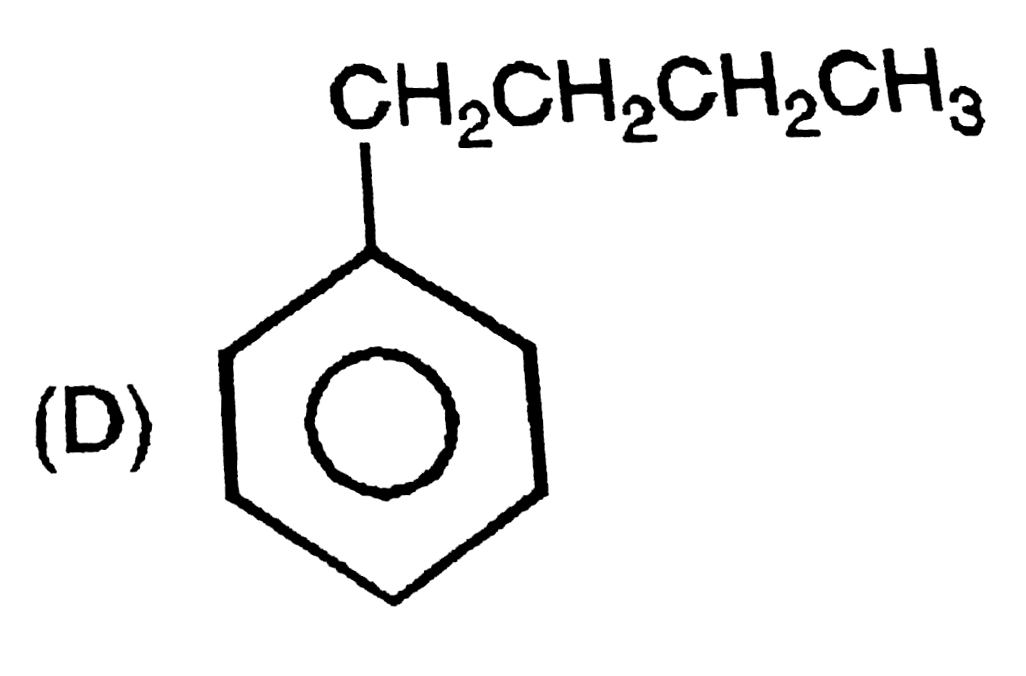The treatment of benzene with isobutene in the presence of sulphuric acid gives
iso− butylbenzene
tert− butylbenzene
n−butylbenzene
no reaction
The correct Answer is:b
To solve the problem of what product is formed when benzene is treated with isobutene in the presence of sulfuric acid, we can follow these steps:
1. Identify the Reactants:
- The reactants are benzene (C6H6) and isobutene (C4H8). Isobutene has the structure CH2=C(CH3)2.
2. Understand the Role of Sulfuric Acid:
- Sulfuric acid (H2SO4) acts as a catalyst and protonates the isobutene, leading to the formation of a carbocation.
3. Formation of Carbocation:
- When isobutene is protonated by sulfuric acid, the double bond between carbon atoms breaks, and a tertiary carbocation is formed. The structure of the carbocation will be (CH3)3C+.
4. Electrophilic Attack on Benzene:
- The formed carbocation (tert-butyl cation) is a strong electrophile and will attack the benzene ring. This results in the formation of a new carbon-carbon bond.
5. Formation of Tert-Butylbenzene:
- After the electrophilic attack, the benzene ring undergoes a rearrangement to restore aromaticity, resulting in the formation of tert-butylbenzene (C10H14).
6. Final Product:
- The final product of the reaction is tert-butylbenzene.
Conclusion:
The treatment of benzene with isobutene in the presence of sulfuric acid gives tert-butylbenzene.
- The reactants are benzene (C6H6) and isobutene (C4H8). Isobutene has the structure CH2=C(CH3)2.
- Sulfuric acid (H2SO4) acts as a catalyst and protonates the isobutene, leading to the formation of a carbocation.
- When isobutene is protonated by sulfuric acid, the double bond between carbon atoms breaks, and a tertiary carbocation is formed. The structure of the carbocation will be (CH3)3C+.
- The formed carbocation (tert-butyl cation) is a strong electrophile and will attack the benzene ring. This results in the formation of a new carbon-carbon bond.
- After the electrophilic attack, the benzene ring undergoes a rearrangement to restore aromaticity, resulting in the formation of tert-butylbenzene (C10H14).
- The final product of the reaction is tert-butylbenzene.
The treatment of benzene with isobutene in the presence of sulfuric acid gives tert-butylbenzene.
Topper's Solved these Questions
- HYDROCARBONSBOOK - A2ZCHAPTER - HYDROCARBONSEXERCISE - Assertion-Reasoning Questions
5 Videos
- HYDROCARBONSBOOK - A2ZCHAPTER - HYDROCARBONSEXERCISE - Section D - Chapter End Test
30 Videos
- HYDROCARBONSBOOK - A2ZCHAPTER - HYDROCARBONSEXERCISE - AIPMT/NEET Questions
36 Videos
- ENVIRONMENTAL CHEMISTRYBOOK - A2ZCHAPTER - ENVIRONMENTAL CHEMISTRYEXERCISE - Section D - Chapter End Test
30 Videos
- HYDROGENBOOK - A2ZCHAPTER - HYDROGENEXERCISE - Section D - Chapter End Test
30 Videos
Similar Questions
Knowledge Check
The treatment of benzene with osobutene in the presence of sulphuriic acid gives
AH2O/H2SO4BHg(OAc)2/H2Ofollowed byNaBH4CB2H6followed byH2O2DCH3CO2H/H2OAlkylation of benzene with isobutene in the presence of sulphuric acid gives
A B
B C
C D
D
The product formed by the treatment of ethanol and ethane nitrile in the presence of sulphuric acid is:
AEthyl acetateBDiethyl etherCEthyl methyl ketoneDButanal
The compound formed on heating chlorobenzene with chloral in the presence of concentrated sulphuric acid is
View SolutionThe product formed by the reaction of acetaldehyde with excess of ethanol in the presence of sulphuric acid is:
View SolutionThe compound formed on heating chlorobenzene with chloral in the presence of concentrated sulphuric acid is:
View SolutionThe compounds formed on heating chlorobenzene with chloral in the presence of concentrated sulphuric acid, is
View SolutionThe compound formed on heating chlorobenzene with chloral in the presence of concentrated sulphuric acid, is:
View Solution
